
 |
Eager Space | Videos by Alpha | Videos by Date | All Video Text | Support | Community | About |
|---|

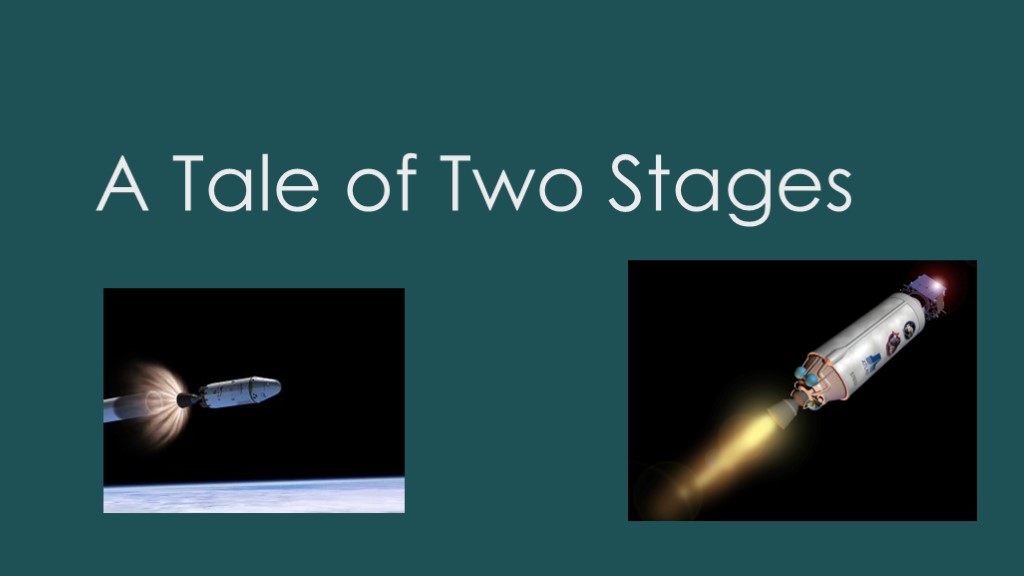
Hello and welcome to a tale of two stages.

This grew out of a mystery, or what I thought was a mystery, having to do with second stages. Let's see if I can frame this appropriately.
So I'm going to talk about two different rockets. I'm going to talk about Falcon 9 on the Starlink 28 mission, And the second stage mass was about 128 tons. The thrust was about 100 tons, so thrust divided by mass gives a thrust to mass ratio of about 0.78.
There's a different rocket, an Atlas 5 Centaur on the NROL-101 mission. Mass 27 tons, thrust 11 tons. So thrust to mass, 0.41. And, okay, what's the mystery? It's like, how do these work? Don't you need to have that ratio be higher than 1? Why don't they just fall out of the sky?
So, that's the mystery that I'm going to talk about in this video. I want to say up front that I heavily used data from flightclub.io, which is just a tremendous resource if you want to dig deep into the details and it shows you just a ridiculous amount of information. So many thanks for the information there.
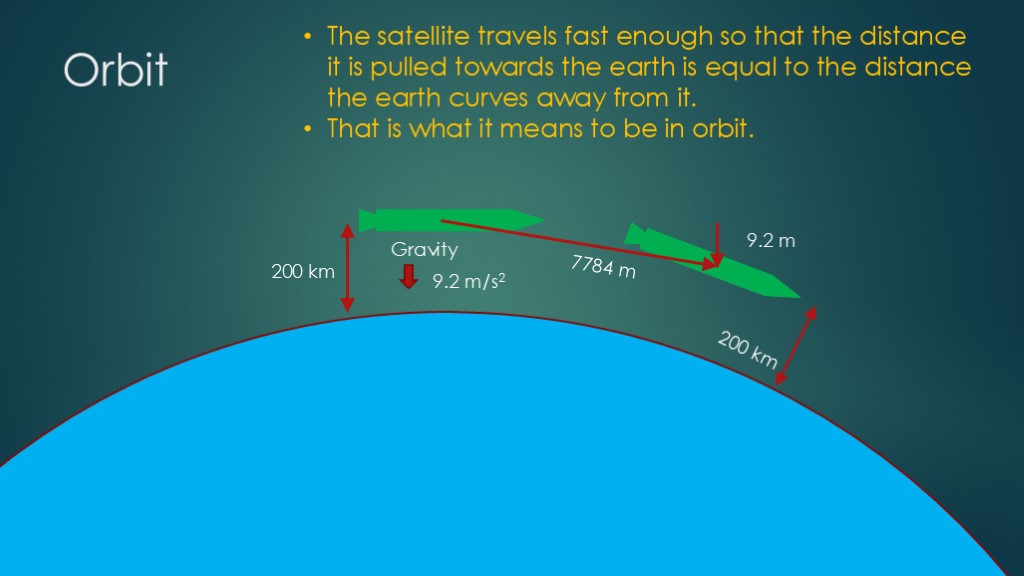
To start, I want to talk about orbit for a little bit because the whole goal of doing these missions is to put something into orbit.
So orbit, here we the earth, here we have our rocket 200 kilometers above the earth, which is kind of the lowest altitude that I would call orbit.
At that orbit, gravity will pull down at about 9.2 meters per second squared, and what that means is if it was just stationary at that altitude, one second would go by a we would move 9.2 meters closer to the earth
(author note: This is right conceptually, but if we started with no velocity towards the earth, we would only travel half that, or 4.6 meters)
So let's think of what happens a second later. If we moved directly forward we would be a little farther away from earth, and our goal is to be right at 200 kilometers. Remember it's going to be pulling us down.
It turns out that if we move forward 7784 meters and move down 9.2 meters, we will still be at 200 kilometers away from the earth.
So in other words the earth is curving away at the same rate that we are being attracted to earth, so that is really what it means to be in orbit. We're moving forward fast enough that the earth attracts the satellite but the earth curves away at the same time and they balance out.
So what does that mean? It means the orbital velocity at 200 kilometers is 7784 meters per second - now if we were farther away from earth, gravity would be less and what would that mean?
Well, that would mean that our velocity would be lower so as we go farther way our orbital velocity goes down, which might be a little counter-intuitive but that's the way the physics work.
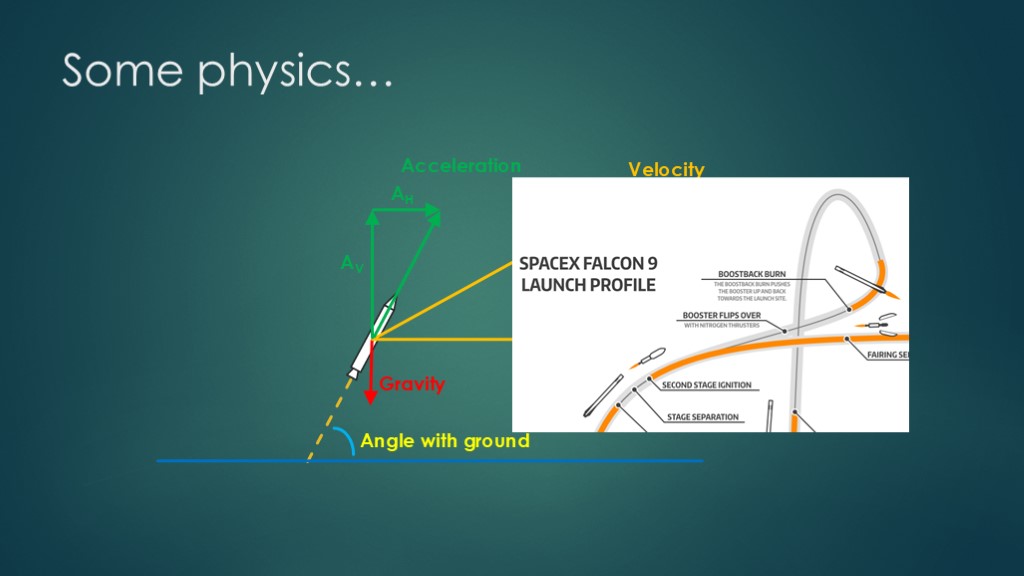
And speaking of physics there's some more details physics that I need to talk about that's going to be the real root of how I analyze and explain what's going on.
So here we have a rocket sometime after launch. We're going to measure the angle it has with the ground so 90 degrees would be straight up and here it's probably 60 degrees. If it's pointing more to the side it's a lower number and then we have acceleration going forward - whatever direction the rocket is pointed.
This arrow is what's called a vector and it really indicates two things - the direction it's pointing is the direction of the acceleration and the length or size of it is the magnitude or amount of acceleration. Vectors are pretty common in physics and they're going to be very useful when we talk about what's going on.
In addition there's a velocity vector and perhaps kind of surprisingly the velocity vector is not necessarily in the same direction as the acceleration vector. It might be more to the side or it might be more vertical. Initially that seems a little weird but if we think about what a Falcon 9 does on some of its launches, the first stage after it separates actually turns around and relights its engines so that its acceleration vector is almost against - in the other direction - of the velocity vector, and then finally there's gravity and gravity always pulls straight down.
Now there's something that's not very convenient about these sort of vectors because one of the things I'm going to care about is gravity pulling us down more than we are accelerating up, but it turns out that we can decompose or break these vectors into separate components so we can take that velocity vector. Here's the horizontal part, and here's the vertical part of the velocity, and we can do the same thing with the acceleration vector and notice that the vertical part of acceleration is not directly in opposition to the gravity, which is always of course vertical.
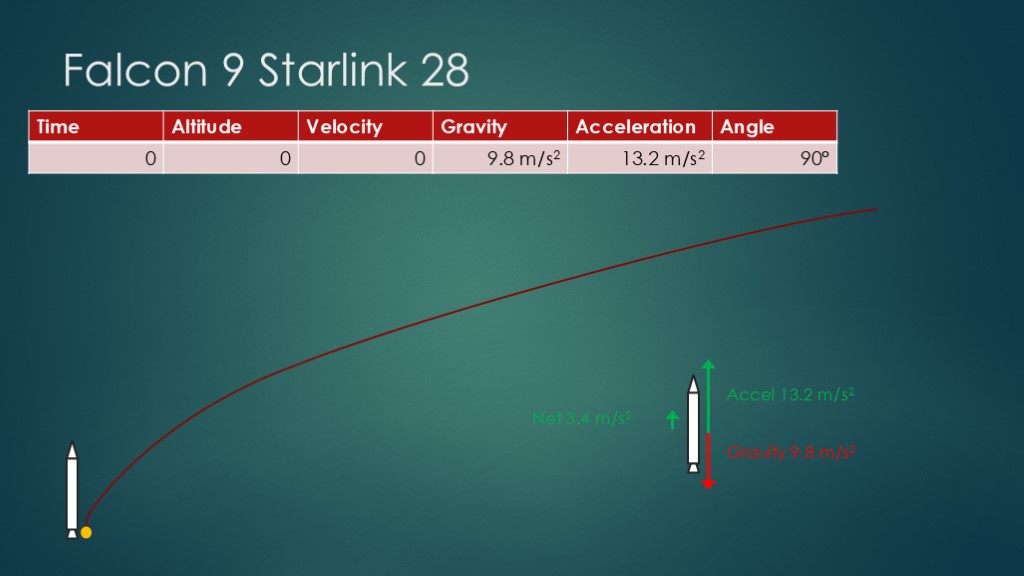
So that's the physics, let's talk about the first mission so the falcon 9 sitting on the launch pad. Here are some stats: time is zero, altitude zero, velocity zero, gravity at the earth's surface is about 9.8 meters per second squared, acceleration when we light the engines is 13.2 meters per second squared, and of course we are pointing straight up.
Now I'm going to draw what in physics is called a free body diagram. This is the rocket and I'm going to draw the force that are acting on it. For the sake of this discussion I'm going to ignore any drag so you won't see that anywhere.
We're accelerating vertically at 13.2 meters per second squared, gravity is pulling us back at 9.8 meters per second squared, and if we add those together, we find we are accelerating upwards at 3.4 meters per second squared. A few things to note. First of all, we had to have a thrust to weight ratio more than one - here we are accelerating up more than gravity pulls us down - or we don't get off the launch pad. The other thing to now is that 3.4 meters per second squared really is not that much acceleration, and that's why when rockets are first launched they don't move very quickly.
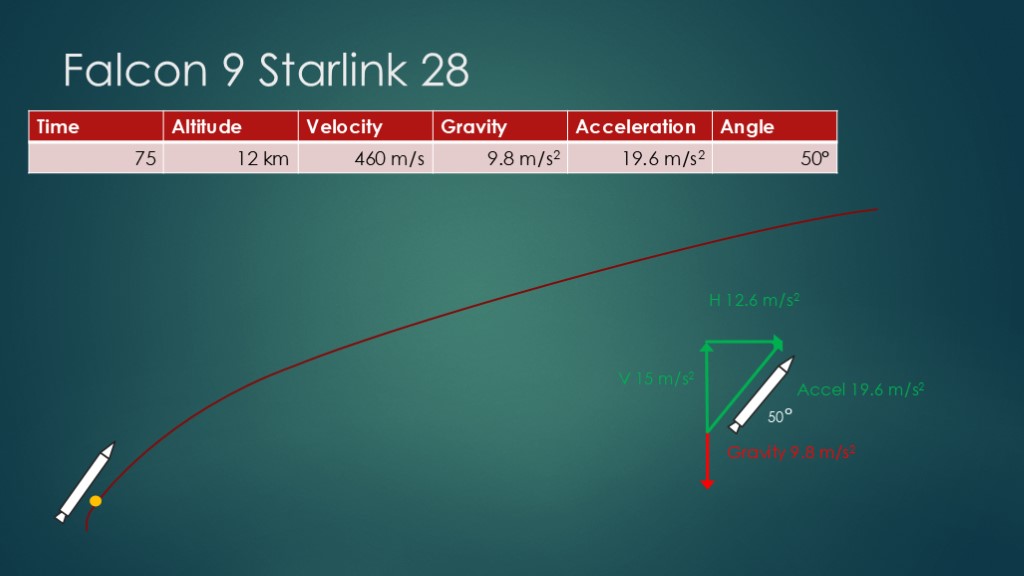
We're going to move ahead a little.
We're at 75 seconds, we're up to 12 kilometers, we're moving at about 460 meters per second so really not very fast, and our acceleration is now up to 19.6 meters per second squared, and the reason it's gone up is we've burned off fuel for 75 seconds so our rocket is much lighter. The angle of the rocket to the ground is now 50 degrees so let's do the diagram.
There we are at 50 degrees, there's our acceleration vector, gravity is pulling us down. We will convert the vector so what we see is our vertical acceleration is still more than gravity so that means our vertical velocity is going to be growing, and we have quite a bit of horizontal acceleration, and this makes a lot of sense - remember, to get into orbit we have to get nearly 8000 meters per second of speed sideways so we need to be building that up.
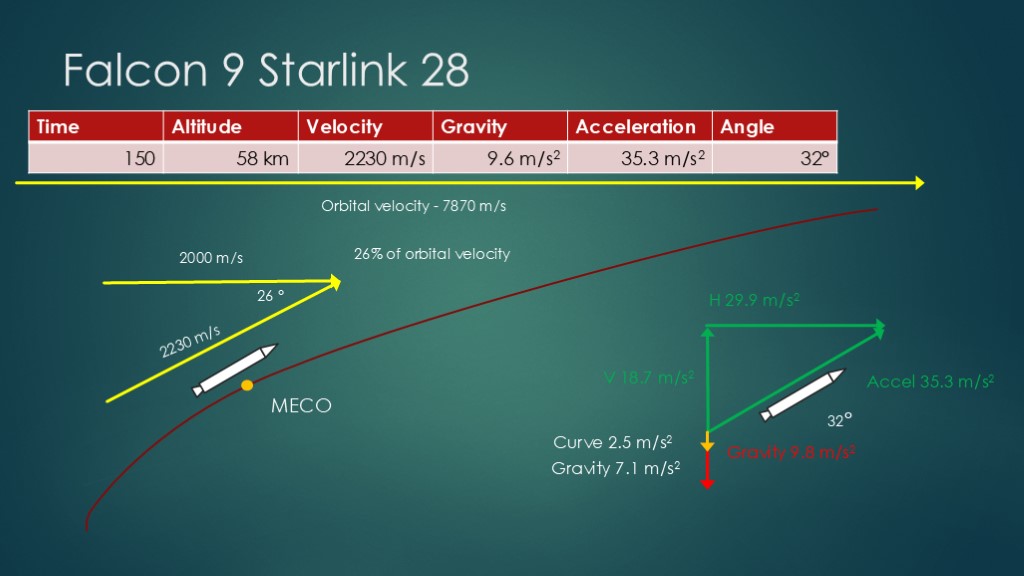
We'll jump again a little bit more to 150 seconds - 58 kilometers, up to 2200 meters per second, gravity is a bit less, our acceleration is all the way up to 35.3 meters per second squared - we've burned almost all the fuel in the first stage - and our angle is down to 32 degrees.
This is approximately MECO, or main engine cut off, so this is right before we are going to stage and switch over to the second stage.
Here's the diagram - here's the acceleration vector, 32 degrees, gravity 9.8 (ed: this is wrong, should be 9.6) and we can see we have a lot of horizontal and lot of vertical, so we'll still be gaining speed vertically right before we shut off these engines.
But there's another factor to take into account. At 58 kilometers our orbital velocity would be 7870 meters per second. We know that our velocity is 2230 meter per second, we known that the angle of the velocity is 26 degrees (Ed: the velocity angle is a bit less than acceleration as we are pointing a little bit high) so we can break that vector apart and we can see that we are moving horizontally at 2000 meters per second. We'll compare that to the orbital velocity and determine we have 26% of the orbital velocity at this point.
That is very interesting. You remember when I was talking about orbit - when we are all the way into orbit the acceleration of gravity was counteracted by the curvature of the earth - here we were about 26% of that velocity. What that means is some of the gravity is counteracted by that curvature - by that horizontal motion - so that curvature is now giving us the equivalent of 2.5 meters per second squared - it's counteracting that much gravity so we still have 7.1 meters per second squared. That means once we've started moving sideways a bunch, we get more vertical acceleration than we think we would.
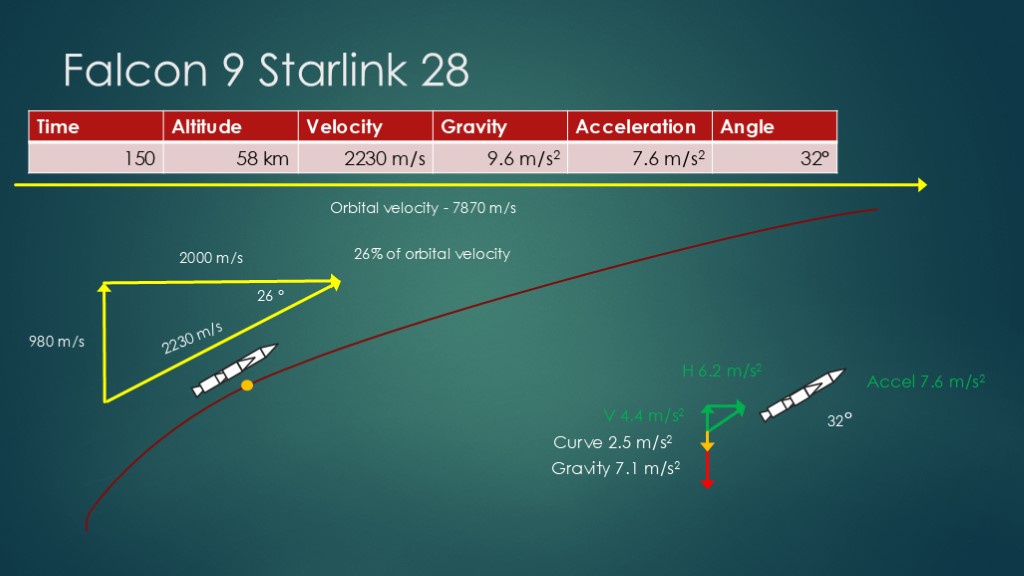
Now we're going to switch over to the second stage. Everything has stayed the same except for the acceleration - we had nine big engines on the first stage, we have one engine on the second stage - so what does that mean? Well, our acceleration is much lower at 7.6 meters per second squared - we see the arrows are much smaller. The important one to note is the vertical acceleration 4.4 meters per second squared while gravity is pulling us down at 7.1 meters per second squared. What does that mean? That means our vertical velocity is going to be decreasing. Now I can finish this diagram on the left side - we can tell that at this point we have a positive vertical velocity of nearly a thousand meters per second, and if you remember our goal with orbit is to have our horizontal velocity be the orbital velocity and our vertical velocity to be essentially zero, so this makes a lot of sense. We want to be slowing down in vertical velocity so that when we get to the orbit we want, we are actually stopped.
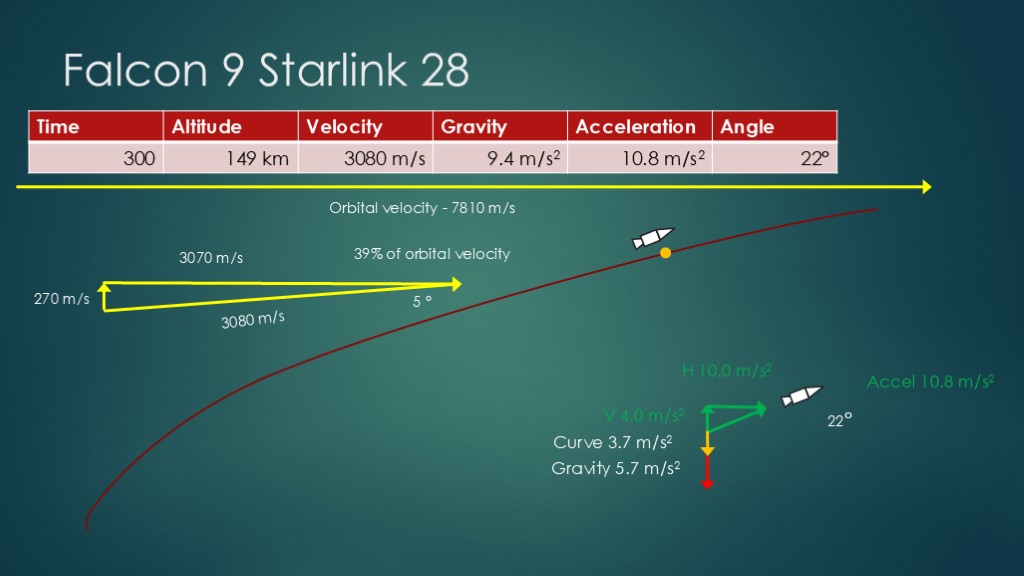
We'll move to 300 seconds: 149 kilometers, our speed is up to 3080 meters per second - we really didn't speed up that much, remember that the second stage accelerates a lot slower - our acceleration is now up to 10.8, our angle is much much farther over - we're pointing more horizontally.
Do the diagram again, 10 meters per second squared going horizontally, 4 meters per second squared going vertical, and we'll do the other diagram - we're not at 5 degrees so we're now pointing much flatter, our vertical is down to 270 meters per second, our horizontal speed is up to 3080 so we're up to 39% of orbital velocity. That's fast enough that we are up to 39% of orbital velocity and that's fast enough that we are now up to 3.7 meters per second squared cancelled out by the curve of the earth, and gravity is still 5.7 so we're still slow down but notice that we still have 270 meters per second so we will still need to slow down a little more to get to zero vertical velocity or something close to that.
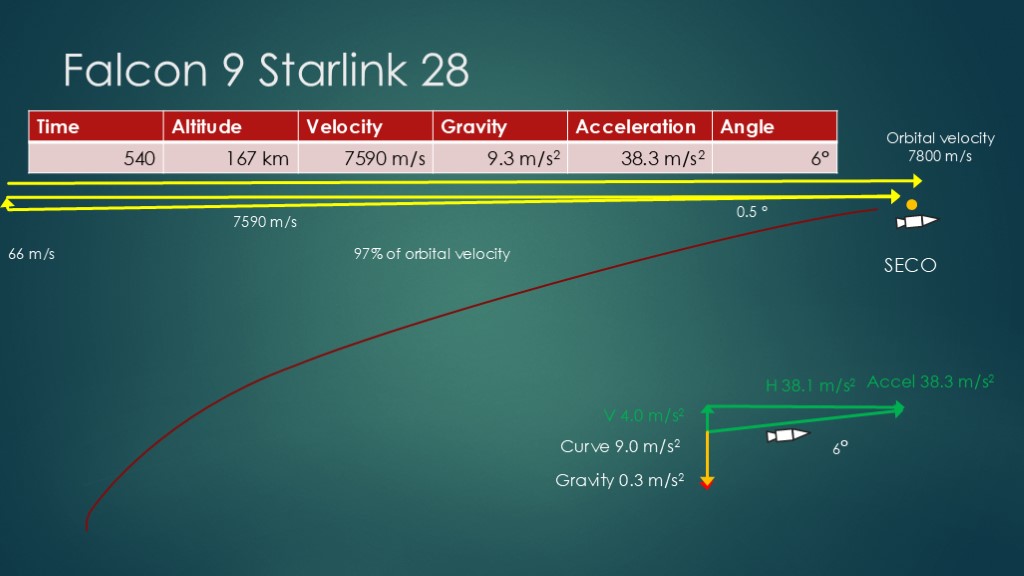
Finally at 540 seconds, 167 kilometers, we are going much faster 7590 meters per second, and we're accelerating at 38.3 meters per second squared, so we've used up almost all of our fuel., so we're accelerating quite quickly and the angle is down to six degrees. This is right before second engine cutoff, so we're almost done getting into orbit.
It's a diagram, so 38.1 meters per second squared sideways and a little bit vertically, and we'll do the other diagram. We're almost flat now - there's very little vertical velocity just barely 66 meters per second, 97% of orbital velocity. That means almost all of gravity is counteracted by the curvature of the earth - we have just a little bit slowing us down - and you can see at this point our vertical acceleration is much greater than gravity so we're actually getting faster vertically again.
There may be some noise in the numbers here - it may be because this is a starlink mission and we aren't actually intending to stop at 167 km - we need to be coasting up higher.
That is what happened on this Falcon 9 launch and you'll notice I didn't' really talk about thrust to weight ration - the interesting part is the first stage's job is to get us moving upwards pretty significantly - a fair bit of vertical velocity - and then the second stage's job is to get us moving sideways and to keep enough of that vertical velocity to get to the altitude we want.
Let's move to the second scenario.
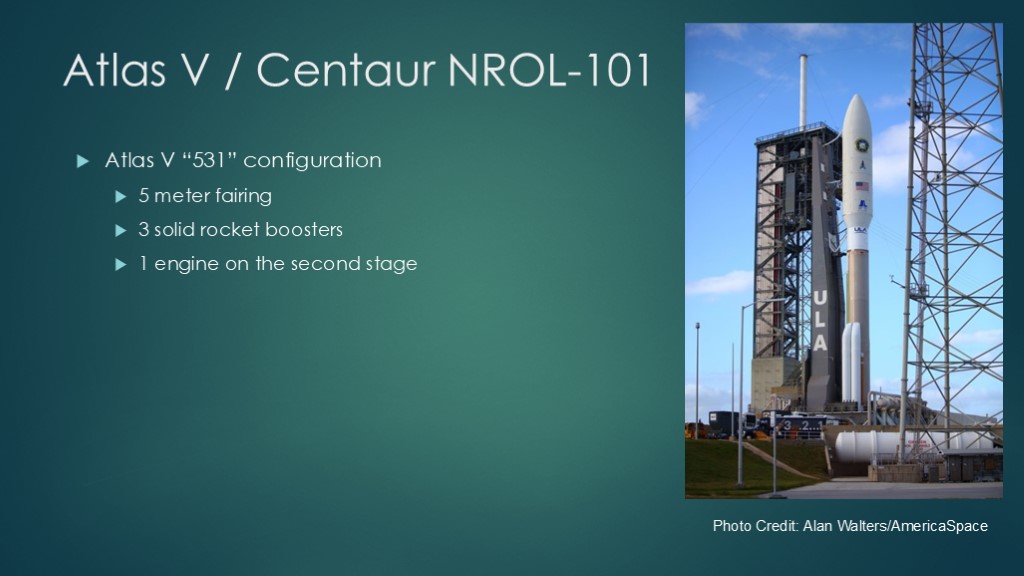
Here we have an Atlas V Centaur on NROL-101. This is the Atlas launching what they call the 531 configuration, which means the fairing on top is 5 meters - you notice it is a big fairing and the satellite is inside that - there are three solid rocket boosters (we can see two on this side there's another one around the other side) and there's a single engine on the second stage so that's what 531 means.
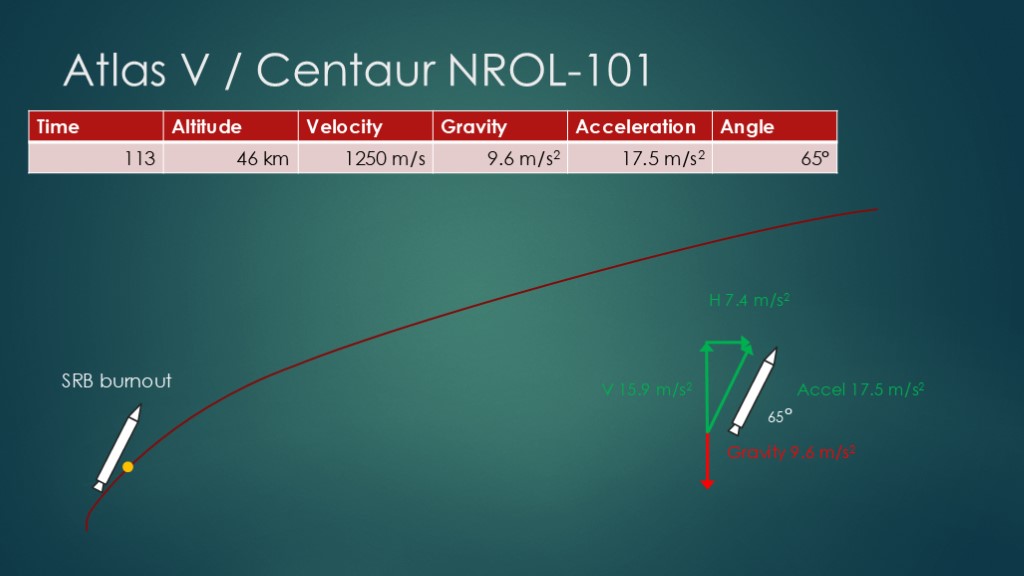
I didn't start on the launch pad because I didn't think it was very interesting, so we're going start at the time when the solid rocket boosters are just finishing, so 113 seconds, 46 kilometers, 1250 meters per second, acceleration of 17.5 meters per second squared and an angle of 65 degrees.
So we're still thrusting upwards pretty significantly - we really haven't started leaning over very much.
Here's the diagram - we're building up a little bit of horizontal velocity but we are really trying to thrust vertically a lot.
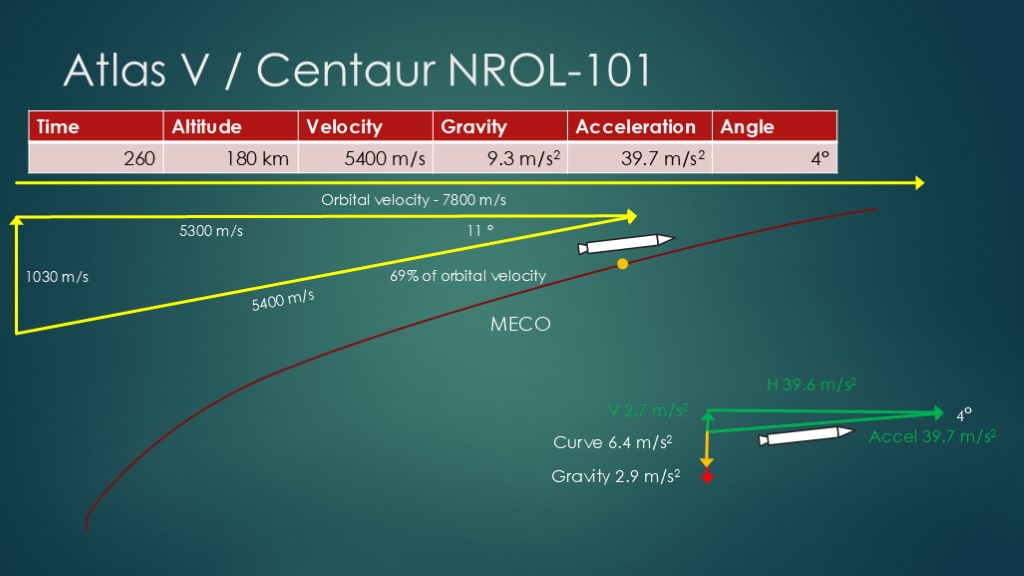
Much later at 260 seconds we hit main engine cutoff so 180 kilometer, 5400 meters per second - that's pretty fast - and we're accelerating at nearly 40 meters per second squared with an angle of 4 degrees.
Let's do the diagram. We wee a lot of horizontal acceleration. We are really trying to build up horizontal velocity at this point, we only have a little bit of vertical acceleration, so lets look at this compared to orbital.
We'll do some vectors. We're at 11 degrees on our velocity that means 5300 meters per second horizontal or 69% of orbital velocity, so that means 6.4 meters per second squared of gravity is counteracted by the curvature of the earth. That leaves us only 2.9 so at this point we're slowing down a little bit, but we're not slowing down a lot, at least in the vertical direction, but that doesn't matter that much as we have over a thousand meters per second of vertical velocity. At this point we'll stage.
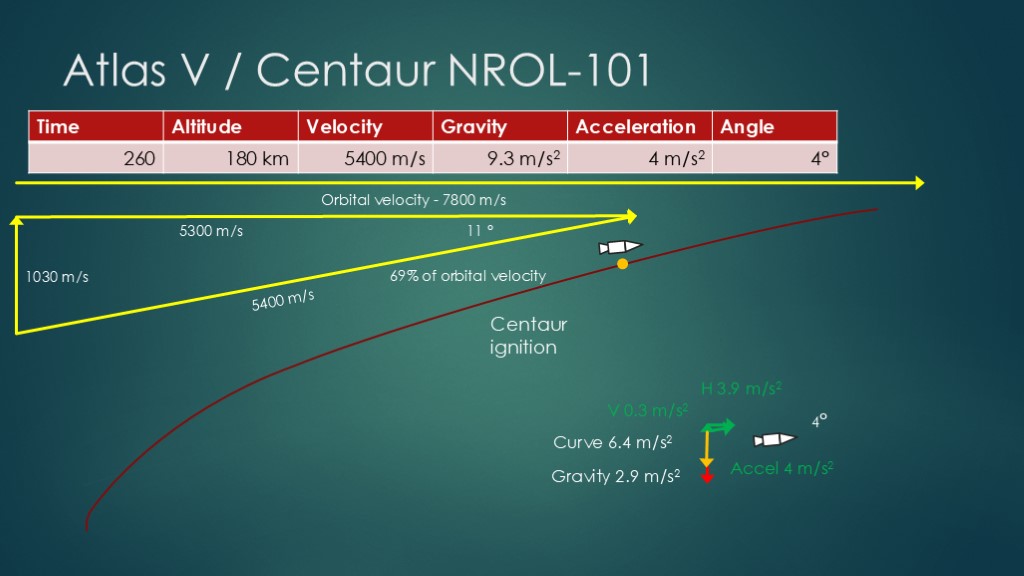
And we're going to light the engine on the second stage and everything stays the same except for the acceleration, and it goes from nearly 40 meters per second squared all the way down to 4 meters per second squared. The RL-10 engine on the centaur is not very powerful; it's very reliable and very efficient but it doesn't put out a lot of thrust and we remember the thrust to weight ratio was 0.4, so lets draw the diagram. A very short arrow here and we s.9 meters per second squared to the side and only 0.3 meters per second squared vertically.
Everything else is the same, what we notice is we have much more acceleration back towards the earth because we lost a lot of vertical acceleration because the engine is so much weaker, so that means we're going to be slowing down vertically relatively quickly but once again the whole goal is to reach orbit; we want no vertical velocity so this is about the time it makes sense, we would want to be slowing down here.
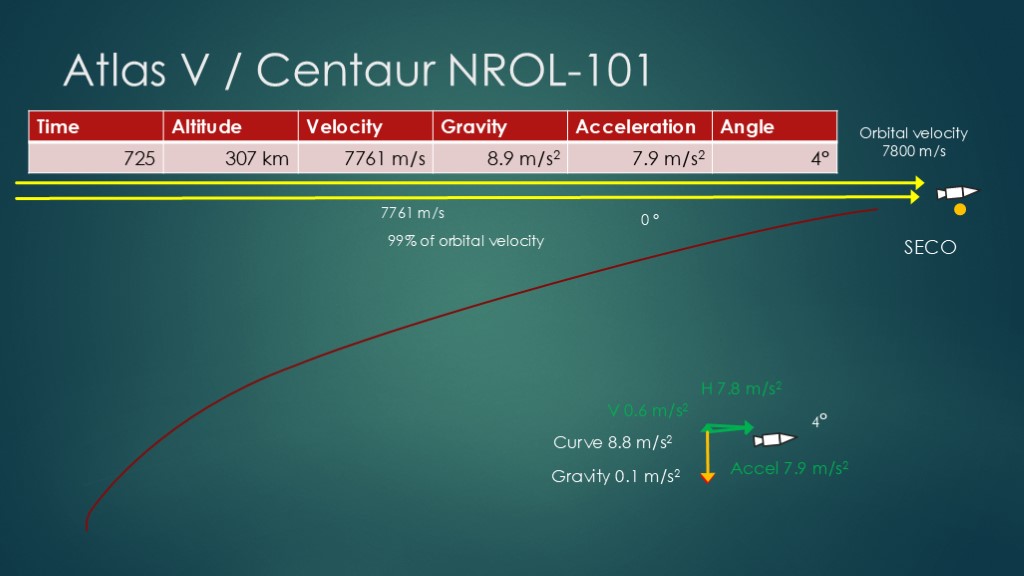
Jump ahead to second engine cutoff at 725 seconds altitude of 307 kilometers, 7700 meters per second and accelerating all the way up to 7.9 meters per second squared, so even when all the fuel is burned the centaur just can't accelerate that quickly.
We'll do the diagram. We're going pretty much at orbital velocity and pretty much all horizontal so there's really no vertical. I've shown that almost all the gravity is counteracted by the c8urve and there's a little bit left pulling us down; there's probably some noise in the figures here as we are pretty much in orbit at this point.
That is what it looked like for this launch with the Atlas V Centaur.
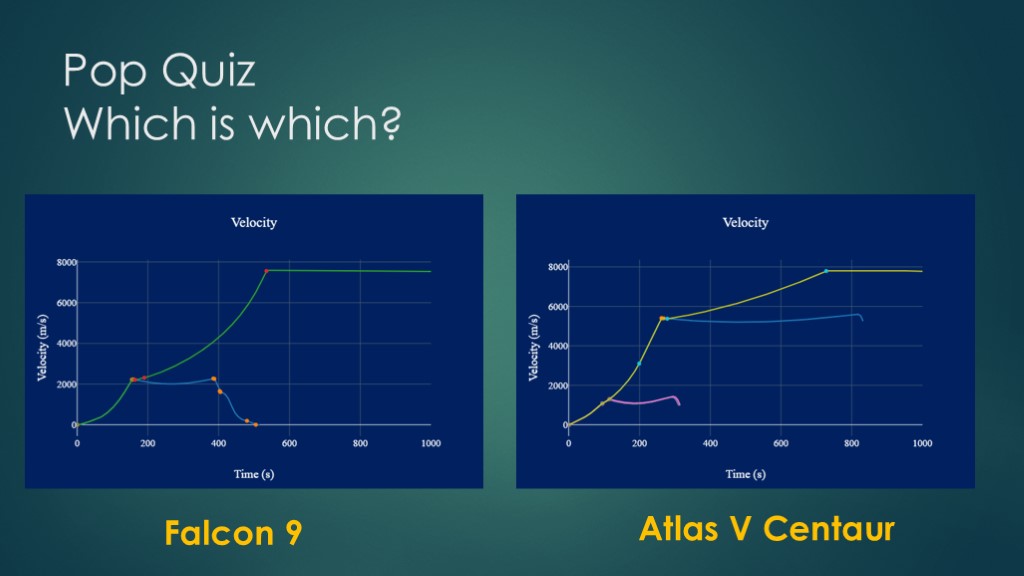
Now I want to compare and contrast them and show you two different views of the two launch side by side, and first we're going to have a little bit of a pop quiz. Here are the two charts showing velocity versus time. Which one was the Falcon 9 and which one was the Atlas V centaur.
It's really pretty obvious; we can tell on the Falcon 9 the first stage booster comes back and lands and we can see that in the left chart - the booster continues and comes back and lands. We know the Atlas V has solid rocket boosters and it has a first stage and second stage so we see in the right chart the solid rocket boosters come off at some point and the first stage comes off, so you can just kind of tell by what they look like.
That's not really why I wanted to look at this charge; I wanted to look mostly at the timing.
We notice on the left we see that the first stage of the Falcon 9 is finished at about 150 seconds and 2200 or 2300 meters per second, and then we have the second stage that does a whole lot of work to go from 2200 all the way up to orbital velocity.
If we look at the Atlas V Centaur, it's very different - the first stage goes all the 5300 or 5500 meters per second so it creates much more velocity than the Falcon 9 first stage, and then the second stage, the centaur is really kind of weak. It takes a long time to generate this small amount of additional velocity.
We see two different launchers, two different kinds of philosophies and the reason they're so different is a different design approach or a different goal on the two teams. On the Atlas V centaur the reason they use the centaur is the centaur is a stage that has been around forever; it's incredibly reliable and it's quite efficient because it uses liquid hydrogen liquid oxygen in the second stage, so it's a very good stage but it's not really great at giving you a lot of delta v.
What that means is that once you decided to use centaur you needed a big beefy first stage and in fact not only do you need a big beefy first stage you may need to augment it with solid rocket boosters for specific payloads. That is why the Atlas V has a big beefy stages and that is why it stages at a high velocity and quick a bit later.
Now flipping over to the Falcon 9, SpaceX knew when they started with the Falcon 9 that they were going to try to reuse the first stage, and they wanted to make that as easy as possible for them. What that meant was they needed to have the first to second stage transition happen at a fairly low velocity so they essentially build a big beefy seconds stage. That could generate a lot of velocity - a lot of delta v - and then build a first stage that could do the rest, and that's really important for recover and reuse because the big challenge for reusing the first stage is making it back into the atmosphere - through reentry - successfully without burning up. That's much much easier if your first stage is travelling at 2200 meters per second than if it's travelling well over 5500 meters per second.
This is one of the reasons why we don't see reuse on the Atlas V - it's probably not possible to bring the whole first stage back through the atmosphere. There's another advantage in this; if you have your staging early it means that if you want to land on a drone ship out in the ocean your drone ship is relatively closer. If you think of how close the SpaceX ones are, which is maybe 400 to 1000 kilometers. In that range if you think the Atlas Centaur ones would have be much much farther out, much later in the flight and that would just be much harder logistically and it would be more expensive, so that is why SpaceX chose to design this sort of way with the big beefy second stage.
There's probably another reason why they chose this; when the Atlas V was designed they had the centaur and everything worked so it didn't make a lot of sense to put a lot of money into a new second stage. SpaceX knew they had to build a new second stage from scratch and they didn't have an engine for it, and it turned out that if they took one of the Merlin engines from the first stage and made a vacuum engine, they ended up with a big beefy engine and that gave them the second stage working the way they wanted it.. It's also true that to get this first stage which is a little less beefy they still needed to use nine merlin engines and nine engines at the time already seemed a little ridiculous. If they wanted to have a beefier first stage they either would have had to accept less payload or they would have had to use even more engines and that of course would be crazy.
Well, of course they're doing it in starship but at the time it was a nice trade-off for them.
So I hope this was interesting. I think it's very interesting to see two very different approach; they're both two stage rockets - I guess you can call the Atlas V two and a half stages if you include the solid rocket boosters - but they have very different philosophies for how they get into orbit.
Now in case you didn't catch it, to go back to the mystery I talked about at the beginning, there's really no mystery because thrust to mass or thrust to weight doesn't really make sense for second stages because second stages start their job when they're already moving horizontally quite a bit and you notice the Falcon 9 second stage - it starts pretty early so we aren't getting much benefit from going horizontal - so it needs to be pretty beefy; it needs actually pretty high thrust to weight ratio.
Atlas V the centaur stage we're already going very fast horizontally so it doesn't need to be as beefy, doesn't need that high thrust to weight.

Thanks for your attention; I hope it was enjoyable.

Please subscribe.